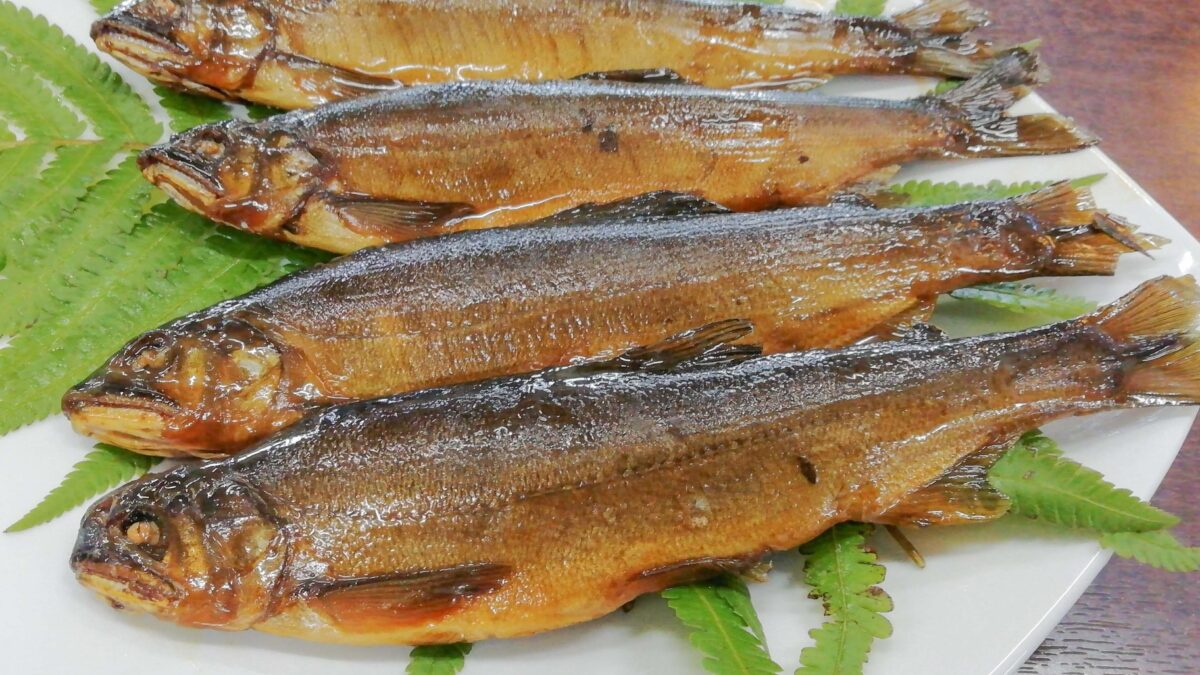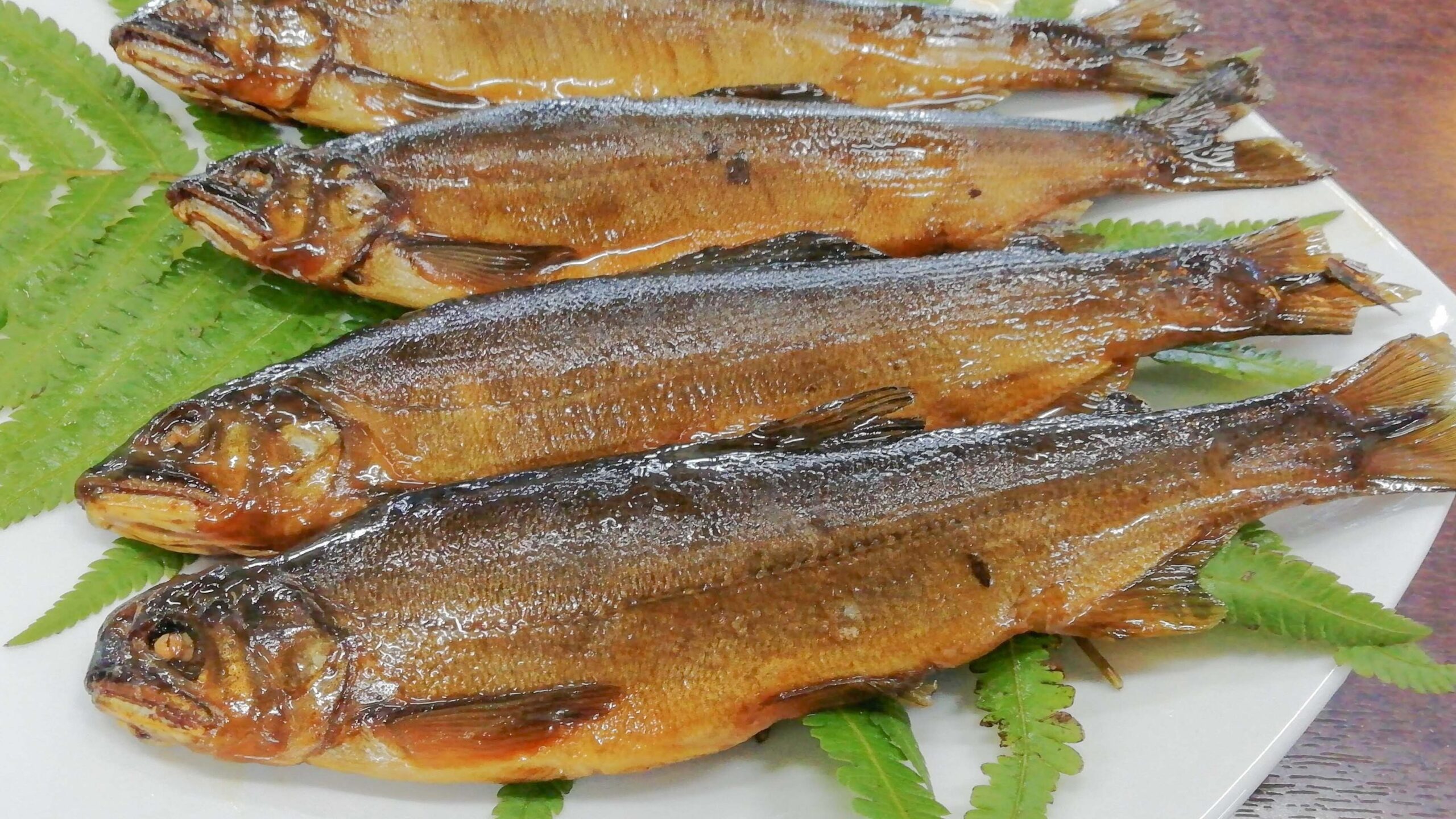
Alright, let’s dive into a sweet and savory delight from Kumamoto Prefecture: “Yaki Ayu no Kanroni.” This dish features “ayu” (sweetfish) that’s grilled and then simmered in a rich, sweet soy sauce glaze. Given Kumamoto’s famous rivers, it’s no surprise that ayu is a local specialty!
Dish Name: Yaki Ayu no Kanroni / 焼鮎の甘露煮
- Region / Location: Hitoyoshi/Kuma region, Yatsushiro region, Kumamoto Prefecture.
- Primary Area of Tradition: Hitoyoshi/Kuma region, Yatsushiro region.
- Main Ingredients: アユ (Ayu/sweetfish).
How It’s Eaten / Served
Kanroni is served with the whole fish presented. It’s delicious even when it’s cold.
Cultural Background and Preservation
The Kuma River is the largest major river in Kumamoto, flowing through the Hitoyoshi Basin, the Yatsushiro Plain, and into the Yatsushiro Sea. Known as one of Japan’s three fastest-flowing rivers, its swift currents and clean water have made it famous for its ayu since ancient times. The strong currents strengthen the ayu’s muscles, and the clear water allows sunlight to reach the riverbed, promoting the growth of abundant algae, which the ayu feed on. The Kawabe River, a tributary, is particularly famous for its large “shaku-ayu,” ayu that can grow up to 30cm!
Kosa Town, through which the Midorikawa River flows, also has “yanaba” (fish weirs), and ayu restaurants are popular there. While there are many famous ayu dishes, such as grilled ayu and ayu sushi, “yaki-ayu” (grilled ayu) made with “ochi-ayu” (ayu that descend the river to spawn in autumn) is a winter preserved food unique to this region. The ayu are skewered, grilled over charcoal until golden brown, and then dried in a drying kiln. They were used to make dashi (broth) for New Year’s zoni and mixed rice dishes.
Kanroni, made by slowly simmering grilled ayu in a sweet soy sauce-based glaze, is also a winter preserved food. A bit of mizuame (starch syrup) is added at the end to give it a nice sheen. You can eat the bones, and the flesh is tender. Ayu with eggs are also a delicacy during this season.
However, the ayu catch in the Kuma River and its estuary, which used to be plentiful until the mid-20th century, has been declining. The Kuma River Fisheries Cooperative is working to protect the resources by catching juvenile ayu at weirs and releasing them throughout the river basin to counteract the effects of dams and weirs that hinder the young fish from swimming upstream.
The sight of “ochi-ayu” being grilled over charcoal is a symbol of autumn. Kanroni made from grilled ayu is a regular dish on the dinner table.
An ekiben (train station bento) featuring grilled ayu, with a whole kanroni ayu on top of rice cooked with the dashi from grilled ayu, is a famous product of JR Yatsushiro Station. Created to coincide with the partial opening of the Kyushu Shinkansen in 2004, it became so popular that it won the Kyushu Ekiben Grand Prix for three consecutive years. You can also buy it at JR Kumamoto Station and JR Hakata Station.
Additional information:
- Ayu (鮎): Sweetfish.
- Kanroni (甘露煮): A cooking method where fish are simmered in a sweet and savory sauce.
- Dashi (だし): Japanese soup stock.
- Ekiben (駅弁): Japanese box lunch sold at train stations.
- Yanaba (簗場): Fish weirs, a traditional method of catching fish.
The information about regional cuisine featured on this website (Piggy's Grandma of Japan) is summarized and adapted from the Ministry of Agriculture, Forestry and Fisheries of Japan (MAFF) website, "Our Regional Cuisines"Additional commentary is provided based on the unique experiences and perspectives of the site's editors.
The copyright for the original content regarding regional cuisine belongs to the Ministry of Agriculture, Forestry and Fisheries of Japan.
The summaries and adaptations published on this site are intended for informational purposes only. Piggy's Grandma of Japan does not guarantee the accuracy or completeness of this information. For the most accurate and complete details, please refer to the original pages on the MAFF website.



